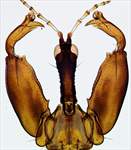
cambagei females

cambagei large female

cambagei pelta & tergites

mantis prosternites

darlingi head

darlingi mouth cone

curiosus

mantis

okrius

darlingi tergites IX-X
Generic diagnosis
Macropterous Phlaeothripinae with long head. Head in large individuals more than twice as long as wide, narrowed to base; eyes longer dorsally than ventrally; maxillary stylets low in head; mouth cone short, genae often expanded to form lobes at base of mouth cone. Antennae 8-segmented, III with one sense cone, IV with 3 sense cones. Pronotum broad, notopleural sutures complete. Prosternal basantra small or represented by several large and partially fused chitinous islets; ferna transverse; mesopresternum of two lateral triangles; metathoracic sternopleural sutures long. Mesonotum usually with median split extending half-way from posterior margin; metanotum reticulate. Fore tarsal tooth usually well developed; fore tibia with sub-apical tooth varying in size; fore femora usually expanded, sometimes with one or two tubercles on inner margin. Fore wing parallel-sided, with 20–45 duplicated cilia. Pelta irregularly triangular with apex truncate, campaniform sensilla present; tergites reticulate, sub-medially with bands of linear striation; II–VI each with 2 or more pairs of small sigmoid setae anterolateral to wing-retaining setae, VII with wing-retaining setae small and straight; tergite IX setae S2 of female sometimes stout, tergite IX setae of male all long and slender; tube relatively short, anal setae dark and nearly twice as long as tube. Male sternite VIII with large pore plate.
Nomenclatural data
Grypothrips Karny, 1924: 27. Type species Grypothrips mantis Karny, 1924, by monotypy.
There are six species recognised in this genus.
Australian species
Grypothrips cambagei Crespi, Morris & Mound, 2004: 194
Grypothrips curiosus Girault, 1927: 1
Grypothrips darlingi Crespi, Morris & Mound, 2004: 196
Grypothrips mantis Karny, 1924: 28
Grypothrips okrius Crespi, Morris & Mound, 2004: 197
Grypothrips papyrocarpae Crespi, Morris & Mound, 2004: 197
Relationship data
Among the Phlaeothripinae of Australia this endemic genus is not clearly related to any other genus. It is presumably derived from among the Liothrips-lineage of leaf-feeding species.
Distribution data
Widespread across Australia, mainly in semi-arid areas but with one species extending into the ACT.
Biological data
Living on various Acacia species in old galls induced by Kladothrips species, also within pairs of tied phyllodes produced by larvae of Lepidoptera .
References
Crespi BJ, Morris DC & Mound LA (2004) Evolution of ecological and behavioural diversity: Australian Acacia thrips as model organisms. Australian Biological Resources Study & Australian National Insect Collection, CSIRO, Canberra, Australia, pp. 1–328.